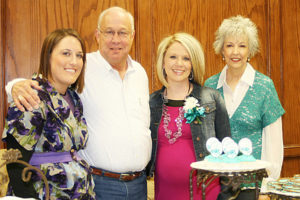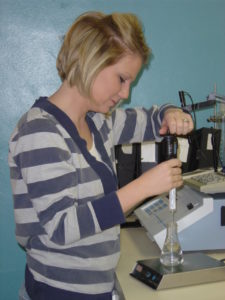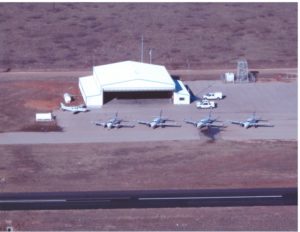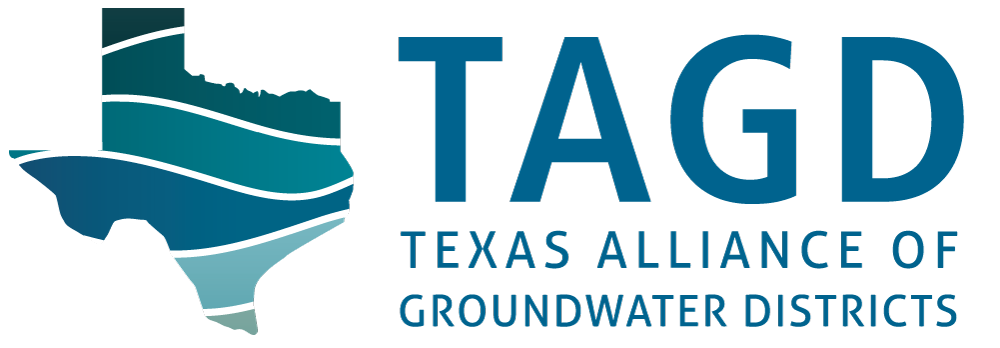Monthly Feature
Sandy Land Underground Water Conservation District
Plains, Texas
Gary Walker, General Manager
 When Gary Walker learned to fly planes in the Navy after graduating from Texas A&M University, he probably couldn’t have imagined where it would lead him. Certainly not to Plains, Texas, where he would run a groundwater conservation district, serve in the Texas Legislature, create an internationally-recognized cloud seeding program, and make permanent roots. But it did, and he wouldn’t change a thing.
When Gary Walker learned to fly planes in the Navy after graduating from Texas A&M University, he probably couldn’t have imagined where it would lead him. Certainly not to Plains, Texas, where he would run a groundwater conservation district, serve in the Texas Legislature, create an internationally-recognized cloud seeding program, and make permanent roots. But it did, and he wouldn’t change a thing.
Gary became the very first General Manager of Sandy Land Underground Water Conservation District in Yoakum County (about 70 miles southwest of Lubbock) in 1990, shortly after the district was created by the Legislature and confirmed by local voters. He moved to Plains from White Deer, Texas, where he had been a cattle rancher before taking on the general manager position at Panhandle Groundwater Conservation District. Gary found his way into groundwater when Richard Bowers (see our previous feature on Central Texas Groundwater Conservation District) approached Gary about the Panhandle position before he left to join North Plains Groundwater Conservation District in Dumas.
In 1990, Gary moved from White Deer to Plains to build Sandy Land UWCD from the ground up. He had one green metal desk and little else, often sleeping in his office until his family made the move to Plains, thus forming permanent roots in the town. As yet another sign of how small and close-knit the groundwater community can be, TAGD President Kathy Turner Jones (Lone Star GCD, Montgomery County) got her start in groundwater management under Gary’s tutelage, joining Sandy Land in 1990 and staying until 2001. When asked about her experience, Kathy credits Gary as the foundation for all of her success in the groundwater arena. Together, Gary, Kathy, and the Sandy Land Board of Directors worked long hours to develop a district unlike any other.
Gary’s community service and stamp on the groundwater world goes far beyond Yoakum County. He represented District 80 in the State Legislature from 1995 to 2003 and he intends to run for the District 85 seat in 2012. More than 20 years ago, he participated in a small gathering of groundwater conservation district representatives in Plainview, Texas. Attendees at that meeting created the Texas Groundwater Conservation Districts Association, the organization that later became TAGD. Gary has served in various positions with the Texas Water Conservation Association and served as President of the national Groundwater Management Districts Association and Vice-Chair of the Texas Water Conservation Advisory Council. He currently serves as Secretary of the Weather Modification Association, and his efforts in that arena have taken him all over the world – from California to India and Turkey.
Gary attributes all of his successes at Sandy Land to his excellent staff and Board members. When asked about his career, Gary replies, “You just have to know that what we do with groundwater and the issues associated with groundwater will make a difference in the lives of our friends and children now and for the future. Thirty years from now, I hope folks will say that guy helped do something good with water on the ground. No matter how it happened, it was good.”
The District
 Sandy Land is a tax-based district that does not collect production fees. Currently, the district has ten full-and part-time employees. In addition to Gary, Gale McDonnell and Amber Blount work in District Administration, Ray Brady is the District’s part-time hydrologist, and Crystal Hogue is the District’s part-time Public Education Coordinator. The District also has an aircraft mechanic, Brian Moore, and four full-time landfill employees.
Sandy Land is a tax-based district that does not collect production fees. Currently, the district has ten full-and part-time employees. In addition to Gary, Gale McDonnell and Amber Blount work in District Administration, Ray Brady is the District’s part-time hydrologist, and Crystal Hogue is the District’s part-time Public Education Coordinator. The District also has an aircraft mechanic, Brian Moore, and four full-time landfill employees.
Like most districts, Sandy Land addresses issues related to water quality and quantity. Irrigated agriculture (mostly cotton and peanuts) makes up the largest groundwater use in the County. In this semi-arid region, producers are continually compensating with fewer acres as the aquifer’s thin saturated material becomes thinner and thinner. Oil and gas uses in the County’s extensive oil field (where saltwater pits and secondary recovery of oil using freshwater are common) are a close second in terms of use. The drought has further impacted the area, causing producers to pump more than ever before and diminishing crops from previous years.
Sandy Land embraces the community and offers services to its citizens wherever possible. The district has an extensive water quality program and has been providing water testing services to citizens for the past 20 years. In addition, the district has issued more than $10 million in low interest TWDB agriculture loans for the purchase of efficient pivot irrigation systems to area farmers, more than any other district in the state. For more Sandy Land specifics, see “District at a Glance” later in this article.
The Landfill
 In 1993, after new federal regulations went into effect concerning the operation of landfills, Yoakum County approached Sandy Land about managing and operating the county’s new landfill. Gary quickly realized the benefit to the public, the County, and the district, and as a result he became a fully-licensed “garbologist”, in his words.
In 1993, after new federal regulations went into effect concerning the operation of landfills, Yoakum County approached Sandy Land about managing and operating the county’s new landfill. Gary quickly realized the benefit to the public, the County, and the district, and as a result he became a fully-licensed “garbologist”, in his words.
The arrangement between the county and the district makes sense, with the district responsible for protecting and conserving groundwater in the area. The landfill has 4 employees and is completely paid for with the County funds, providing an excellent example of cooperation among local entities.
Weather Modification Program
In 1995, the Texas Legislature enacted a $5 million cost-sharing program for conducting activities to increase rainfall through “seeding” clouds. Sandy Land, recognizing that rain enhancement was a natural fit for protecting and conserving the aquifers in Yoakum County, was one of the first groundwater conservation districts to sign up for the program. The district purchased a plane using interest from those low-interest agricultural loans provided to local producers, and local oil and gas companies  participated in the early years. Since it began, the program has been entirely self-sufficient, and no tax money has been used.
participated in the early years. Since it began, the program has been entirely self-sufficient, and no tax money has been used.
In the early days, Gary flew the plane himself, and still does sometimes. In 2004, the district used federal money to outfit a research airplane that they have since sent to Turkey, India, and California. As a result, Sandy Land is at the forefront of seeding operations and atmospheric research not only in Texas, but across the world.
District at a Glance
- Creation: 1989; Senate Bill 1777 (confirmation election in November 1989); Acts 1989, 71st R.S., ch. 673; General and Special Laws of Texas.
- Boundaries: Coextensive with Yoakum County
- Aquifers: Major Aquifer: Ogallala; Minor Aquifers: Dockum
- Board members: Five elected board members serving staggered four-year terms
- Meetings: Regular meetings are the second Wednesday of the month in the District office in Plains
- Largest water user: Agriculture is the largest user group, followed by oil field use in second and municipal use in a distant third (Denver City and Plains are the only two cities in the district)
- Regulation Methods: Well spacing (300 feet from the property line) and production limits (five gpm/acre)
- Permitting: All non-exempt wells are required to have operating permits
